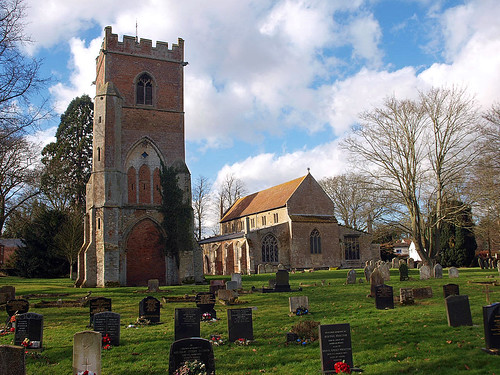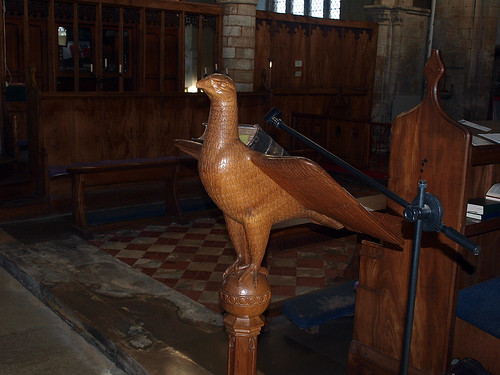ST GILES. The church is a surprise in more than one way. It is (or was) very large, it has a tower in an isolated position to the S of the former chancel (which was 50 by 20 ft in size), and an interior quite unexpected after the exterior. The nave arcades of six bays have circular Late Norman or Transitional piers with circular capitals which on the N side are scalloped or have the most elementary upright leaves. The date of this part is probably late C12. The s arcade is a little later, see the alternation of scalloped with simple stiff-leaf capitals (just a band of overhanging leaves along the upper half of the capital). The arches are round on both sides, but already double-chamfered. Then follows the W bay, built perhaps in replacement of a former Norman W tower. Here the arches are pointed. Contemporary the pointed chancel arch with stiff-leaf capitals. To the l. and r. of it elongated round-headed recesses. Could they be former Norman windows? Above the chancel arch a bigger Norman window. Everything to the E of this arch has disappeared, in the restoration of Sir George Gilbert Scott and his son Oldrid Scott. Sir George was the brother of the then rector. What he pulled down was not the medieval chancel, but an C18 successor. The exterior of the nave is not indicative of the C12 and C13 work inside. The W front is Dec with an ogee-headed and crocketed doorway, three niches above and a five-light window. To the l. and r. buttresses and turrets, then the aisle fronts. Both aisles have also Dec (mixed with some Perp) windows and doorways. The clerestory is Perp. With so much Dec work preserved, it seems fortunate that an inscription of the C14 also survives which reads: ‘Cest piler comencat Ricarde le Prestre Primer preyez pur lui’. However, the ‘piler’ in question is one of the N arcade piers and shows no signs of being later than its neighbours. The tower was apparently begun in the early C13. Whatever the reason for its isolated position, it is paralleled in Norfolk at West Walton and Terrington St Clement, both not far from Tydd. The tower was originally open towards all four sides. The buttresses are of the set-back type. The ground-floor arches are triple-chamfered on demi-shafts with moulded capitals. The stage above has large blank arches with nook-shafts. On the inner shaft rests the arch of an arcade of three lancets. The shafts between the lancets are polygonal. The upper parts of the tower with its battlements are of brick and much later. - PLATE. Cup and Cover of 1569. - MONUMENT. Foliated slab of grey marble to Sir john Fysner, C13.
TYDD-ST-GILES. Its sister Tydd St Mary lies over the border in Lincolnshire; all the tale of the Cambridgeshire Tydd is told in its church, which captures attention at once by the fact that its tower stands 50 feet away. It has stood for 700 years, though its upper stages were rebuilt in brick 500 years ago. Its triple lancets are now blocked up, and so are two of its arches. Under the other two we can walk. The rest of the church is the old nave and aisles, with arcades running the whole length from east to west, and with a richly moulded chancel arch framing the east window. The 13th century arches are crowned with 15th century clerestories, and their capitals are of great interest in showing the growth of ornament from the conventional scallop and leaf to the natural foliage and drooping leaves. The finely carved font is 500 years old, and a coffin stone in the floor of an aisle is 700. On a pillar is a worn inscription in old French, saying: “This pillar Richard the Priest first began; pray for him.”
Tydd St Giles claims Nicholas Breakspear as a curate. It is a resounding claim, for he is the only Englishman who ever sat in the chair of St Peter, becoming Adrian the Fourth.
Tydd St Giles claims Nicholas Breakspear as a curate. It is a resounding claim, for he is the only Englishman who ever sat in the chair of St Peter, becoming Adrian the Fourth.



No comments:
Post a Comment